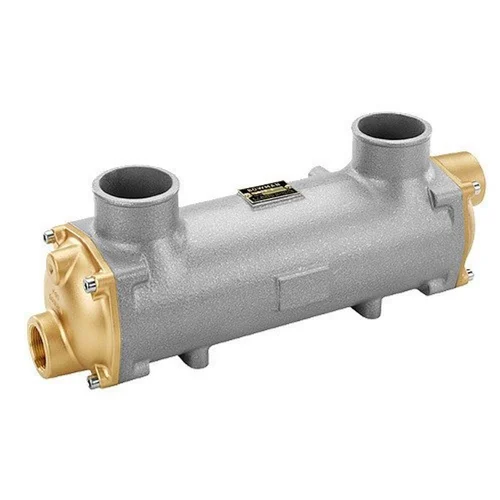Introduction
Marine Hydraulic Oil Cooler is a critical component installed in the hydraulic systems of ships, offshore rigs, and marine platforms. Hydraulic systems control vital equipment such as steering gears, winches, cranes, stabilizers, and hatch covers. These systems generate a significant amount of heat during operation, and if this heat is not removed efficiently, it can degrade hydraulic oil quality, reduce system efficiency, and damage components. The oil cooler transfers heat from the hydraulic oil to a cooling medium like seawater, freshwater, or air, maintaining the optimal oil temperature for consistent hydraulic system performance and preventing breakdowns.
Key Features of Marine Hydraulic Oil Cooler
Corrosion-Resistant Construction
Marine hydraulic oil coolers are constantly exposed to seawater, which is highly corrosive. To combat this:
- Cupronickel (90/10 or 70/30) is widely used for tubing and shells due to its excellent resistance to seawater corrosion and biofouling.
- Titanium is used in highly demanding applications where absolute corrosion resistance and lightweight construction are required.
- Stainless Steel 316L is used for freshwater-cooled units and provides great corrosion resistance in slightly saline environments.
- Marine-Grade Brass is often used for smaller units due to its good strength and resistance.
These materials ensure durability and longevity even in aggressive saltwater atmospheres.
High Heat Transfer Efficiency
These coolers are designed to transfer heat effectively from hot hydraulic oil to the cooling medium (typically seawater or freshwater). Efficiency is enhanced by:
- Increased surface area via finned or corrugated plates or tubes.
- Counterflow or crossflow design, allowing maximum thermal exchange.
- Optimized flow paths, ensuring uniform distribution and minimal thermal resistance.
This allows the cooler to bring down oil temperature quickly, even under peak load conditions, thus maintaining viscosity and protecting hydraulic components.
Compact and Space-Saving Design
Space is always at a premium onboard ships and offshore vessels. Marine oil coolers are:
- Compact in footprint, allowing installation in tight engine rooms or machinery spaces.
- Offered in vertical and horizontal configurations to suit your available space.
- Modular and customizable, allowing you to select size, orientation, and flow arrangements based on ship layout and application needs.
Their lightweight and stackable designs also reduce structural load and ease transportation and installation.
Easy Maintenance
To ensure reliability and reduce downtime at sea, these coolers are:
- Built with removable tube bundles or plate cassettes for direct mechanical cleaning.
- Designed for Clean-In-Place (CIP) operations, allowing flushing of deposits or marine growth without disassembling.
- Equipped with anode protection to reduce internal corrosion.
- Feature easily replaceable gaskets, seals, and O-rings, making maintenance simple even by onboard personnel.
Routine maintenance helps keep the cooling efficiency high and prolongs the service life.
Working Principle
The hydraulic oil cooler operates based on indirect heat transfer. Here’s how:
- Hot hydraulic oil enters the cooler from the hydraulic circuit.
- It flows through a network of tubes or plates.
- Simultaneously, seawater or freshwater passes over or across the heat transfer surface on the other side.
- Heat is transferred from the oil to the cooling water without mixing the two fluids.
- The cooled oil is returned to the system, and the heated water is discharged overboard or into a secondary loop.
This process ensures that the hydraulic oil temperature remains within a safe operating range to prevent system wear or failure.
Applications in Marine Industry
Marine hydraulic oil coolers are used in:
- Ship steering systems – keeping oil cool to ensure reliable navigation.
- Deck winches and cranes – critical for cargo operations.
- Stabilizer systems – for roll control and passenger comfort.
- Hatch cover operation systems – hydraulic cylinders require temperature-stable oil for smooth opening/closing.
- Subsea hydraulic tools and ROVs – compact coolers provide thermal control in deep-sea conditions.
- Offshore rigs – used in hydraulic skids and drilling machinery.
- Tug boats, fishing vessels, and military crafts – where oil temperature control is essential in all-weather conditions.
Common Types of Marine Hydraulic Oil Cooler
Shell and Tube Coolers
- Ideal for high flow rates and rugged marine operations.
- Tubes are housed inside a shell and use seawater as the cooling medium.
- Easy to dismantle and clean.
Plate Type Coolers
- Compact and efficient.
- Suitable for applications where space is tight.
- Plates create multiple narrow channels, increasing surface area and improving heat exchange.
Finned Tube Coolers
- Used in air-cooled systems.
- Extended surface area through fins provides improved heat dissipation using ambient air — suitable for above-deck or offshore crane systems.
Conclusion
Marine hydraulic oil coolers are an essential component in maintaining the performance, safety, and longevity of hydraulic systems onboard ships, offshore platforms, and marine equipment. By effectively controlling the temperature of hydraulic oil, these coolers prevent overheating, reduce system wear, and ensure consistent operation even in the harshest marine environments. With their corrosion-resistant materials, compact designs, and high thermal efficiency, marine hydraulic oil coolers are engineered to meet the demanding conditions of saltwater applications. Their ease of maintenance and customizable configurations make them a smart, reliable, and long-term investment for vessel operators and offshore engineers.

